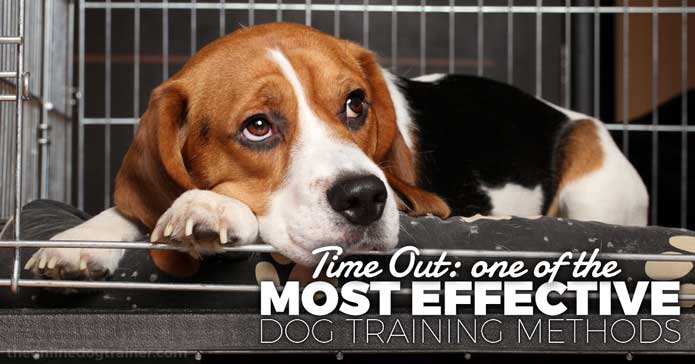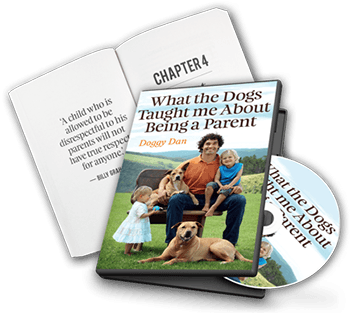
When you hear the word “time out,” you probably envision a small child getting sent to his or her room for a few minutes as a punishment for doing something naughty.
Why?
Because it’s a safe, kind and effective training method that works to help children understand and cool down when their behavior has been less than desirable.
(See how I've trained over 88,000 dogs with kind, gentle techniques here!)
While it’s common knowledge that this discipline method works wonders for children, I’m here today to let you in on a little secret.
Time outs work equally as well for dogs! Pretty neat, right?

Believe it or not, I have stopped more unwanted dog behaviors using this simple tool than any other approach. And the best part…this disciplinary action is calm, kind and gentle–three things I believe are so important when training a dog.
I’ve had so much success using the time out method, I even wrote an entire chapter about it in my book, What the Dogs Taught Me About Being a Parent.
If you know my dog training techniques, you know the methods I use are kind and gentle and that I encourage all dog owners to take the gentle approach to curbing their dog’s behavior.
So, in an effort to help you and countless people around the world equip themselves with gentle training techniques, I want to give you a FREE audio chapter of my book What the Dogs Taught Me About Being a Parent that explains how to use doggy time out efficiently and effectively.
The chapter is called “Time Out Is A Beautiful Thing.” And I truly believe it is, since it has been one of the most useful and helpful tools in raising both my two children and my 4 dogs.
Listen to the audio, and you’ll discover…
- Why time out is so powerful as a training tool for dogs.
- Why simply telling your dog off often does not work.
- How to implement a time out so it has maximum effect.
- The power of remaining calm and silent when you are giving a time out.
- The benefits time outs provide for you and your dog.
Download your free copy of the chapter here, or listen to it below:

Be it raising our kids, training dogs or stopping chickens from pooping all over our brand-new concrete driveway, it’s become crystal clear to me that the best and most effective training methods are those that are gentle and kind.

While I am a firm believer that dogs and kids also need clear boundaries and that they often need to be reinforced with consequences, I don’t believe that those consequences have to entail fighting, yelling or hitting.
For that reason, my mantra is that we need to use calm, consistent consequences with our dogs (and kids!).
Of course, it goes without saying that I always encourage dog owners to reward desired behaviors using some positive reinforcement, be it pats, cuddles or a reward such as a ballgame.
So, what happens then if the time out doesn’t work and your dog comes out and repeats a bad behavior?
Easy…
Repeat the process of putting your dog in time out.
And what if you repeat the process multiple times and it really doesn’t work and you seem to be getting nowhere?
If it’s not working, I would suggest that the reason is because your dog thinks that he is in charge and you really have no right to put him into time out!
Let me explain!
Think of it as if a child tried to put his parent in time out because the parent did something the child didn't like.
You think the parent will accept that and change their behavior? Think again.
The one who is at the top of the hierarchy makes the rules and does the disciplining. So, if you are really struggling with your dog’s behaviors, then it's likely that your dog is at the top of the hierarchy and that you need to take a look at a complete training program and revisit how your dog views your position in the pack.
Honestly, nobody wants to be shouting at their dog the whole time, and there is nothing more annoying than having to repeat what you have asked again and again. Which is why saving your voice when using a time out and having another way of reinforcing what you have asked for is super powerful, and one of the most effective dog training methods.
So, when I am working with the dogs, or my kids, I use the following words to keep myself in the right zone…
Calm and Clear… Firm and Fair. Or in the words of a great man….
“Nothing strengthens authority so much as silence” – Leonardo Da Vinci
While you’re here, don’t forget to download your FREE chapter on time out training!
Download your free copy of the chapter here
If you really enjoyed the free chapter, you can purchase my entire Audio Book here.
Or, if you’re just looking to pick up some extra tips and tools, I encourage you to check out additional posts on my blog!
Enjoy!

~Doggy Dan 🙂








19 Responses
Hi.
I am a 60 yr old disabled MC Veteran. I gave a 7 yr old GSD as a service dog. He always has a tude but the last couple of years…homelessness and COVID19 he has gotten cocky. He listens when he wants. If corrected, he pees. Correction is a no or time out. He now is a attention whore. I can be talking to someone and he whines or bugs them while ignoring me. This last stunt we went for a walk and he liberally refused to keep walking when I refused to let him check out dogs walking past us. I either had to carry or drag him. I had someone help me get him back home. Because of him refusing to walk and acted up as he did…he got overheated and I had to literally hose him down. Now. Because of that stunt when I go put the leash on he pees. So. I do a time out. No one will watch him if I go on vacay or will do any training with him. He literally refuses to listen at times. When he does. He is great. So will time outside correct this attitude? Especially the peeing when I go put his leash on?
Hi Connie,
A change in routine and environment can be really unsettling for dogs and it can lead to them exhibiting behaviours they may not have previously. It can then lead to them needing a little extra reassurance that they can trust their human to keep them safe no matter what situation they are in. So I would say that your dog’s behaviour is common amongst dogs who find themselves in similar circumstances. Dogs will even push themselves to the bring of exhaustion if they feel they are performing a role that allows them to keep their family/pack safe. If you are familiar with my Dog Calming Code (DCC) then revisiting those principles and tightening up on any inconsistencies will certainly help your dog settle and return to their usual behaviour. If you are not familiar with my DCC then maybe take a look at my website TheOnlineDogTrainer.com sh to achieve this…its a $1USD trial for 3 days…all the best Doggy Dan
Help. Advice. I’m beyond frustrated with my Dachshund. She’s a year and a half old. The first year of her life she peed and pooped on my bed whenever she had the chance. So now the bedroom doors stay closed when I’m not in there. She has a doggy door and uses it a hundred times a day. She hasn’t had any accidents in months and I can’t remember the last time she peed on my bed. She’s potty trained. Goes outside then runs to the pantry for her “good girl” treat. Every single time. She will wake me up in the middle of the night to go out with her. I think she’s scared of the dark lol. Anyways she’s been soooooo good. Today I went in the closet to put clothes away and she peed and pooped on my bed!!!! I’m so frustrated with her. I’ve taken her to vet. I’ve researched tons. Read that it’s where my smell is strongest and makes her feel safe. But I don’t care …. she has to not pee on my bed! She sleeps with me every night so her scent is there too. I am at a complete loss for what to do!
Hi Heather! Dogs that pee or poop indoors are generally doing that for good reasons in their mind. It may be a way of gaining attention or it may be them scent marking…dogs who toilet indoors when their owners are out can be a symptom of Separation Anxiety. It is a behaviour that you can overcome and we do cover it on my membership website…maybe take a look….we have a trial offer of $1USD for 3 days…all the best Doggy Dan
I’m trying to select a spot for time out. Our puppy is coming home with us this week. Is the bathroom a bad idea if we will later want to take him there for baths? I’m not sure what else to use. Advice?
Hi Sally,
With young puppies you can use puppy pens or even their crate for a Time-Out, but your bathroom is also fine. The issue with not wanting to create a negative association with a place you would like them to view positively, is a common question we get. Dogs and puppies are smart enough to know the difference between that location being used for a positive (to sleep) or negative (time-out) occasion, because it’s all dependent on the way you send them to that area. For positive occasions you may use praise and a treat but if they are receiving a time-out then it’s immediately after an unwanted behaviour and there would be no praise or treat given. Good luck! Doggy Dan
When we go for walks she goes crazy when she sees other dogs or people. I try to turn her away from them, but she is very strong and turns back around. I took to trainer she is like grab her and put between your legs so she can’t see but that does not work because of her strength she can turn her head still.
Hi Carole,
It’s common for a lot of dogs to feel a little anxious or unsettled around strange people and dogs, because they can view them as potential dangers. Something that may help is to give your dog a little extra space when approaching strange dogs or people…. or you may need to give her a lot of space if she is really agitated. Calmly crossing the Street or moving over to the side of the footpath will mean the ‘danger’ is getting further away and will best allow her to stay calm. My website TheOnlineDogTrainer.com also has lots of advice about this behaviour…maybe take a quick look…its a $1 trial for 3 days…all the best Doggy Dan
It was getting near supper time the other day, and I went into panic mode because I couldn’t find my dog Penny. I had recently been outside and I was afraid she had sneaked out the door behind me. I went outside calling her name and whistling, which she always responds to, but no site of her. I told my husband I couldn’t find her and he was going to go out in the car and look for her. But as he walked down the hall, he saw the bathroom door closed. He opened it up and there was Penny resting quietly on the floor, where I had put in her time out about 45 minutes ago! Lesson learned…always set the alarm on my phone when I put her in time-out as my memory is not what it used to be. Poor Penny. Not sure if she learned anything except that I have am a few cards short of a deck!
Haha, poor Penny! I’m pretty sure I’ve done this a few times myself! Best, Doggy Dan
Hi, our 10 week old puppy hates to be by herself. When she goes in to timeout, she whines and barks and throws herself against the door. Do we just wait until she calms down for 30 seconds, which may be about 20 minutes? We want to start the timeout right away, but need to work on separation from her, which may take a wee while.
Thanks!
Hi Emma,
With young puppies, especially those who become stressed at being separated from their family, you can shorten the required quiet time to 5-10 seconds. Remember though if you have a puppy pen or crate that you can use this for time-out as with younger puppies this seems to be a big enough consequence for them to moderate their behaviour. Keep an eye on your puppy’s anxiety when she is alone as this could be developing into a case of Separation Anxiety and the sooner you work her through it the better. She is only still young and no doubt getting used to her new home but if she doesn’t show signs of calming down when she is left alone then My website TheOnlineDogTrainer.com shows you very clearly how to achieve this…maybe take a quick look…its a $1 trial for 3 days…all the best Doggy Dan
Hi Dan thanks for your blog, i enjoyed the 6 month membership and now the Blogs i get. we have a 11 month old cavapoo who i am training to be a therapy dog. About 7 weeks ago i was away and sent my dog to the trainer i have been using for the 6 days we were away, he came home barking in the crate, shutting down and not listening to basics like down and sometimes leave it. At a class i attended after we came back, i was dismayed to see tons of leash popping and the use of a prong collar. They had given me the collar but i didnt want to use that form of punishment. Now my dog refuses to go into his crate, and barks at every little noise, people outside or the door. I have left the trainer as i as slowly earning his trust again without leash corrections or such collars. I still am working on crate without much success, and for barking i figured timeout always worked with my kids, slowly he is barking less but still he will a few times a day. Do you have any other suggestions for getting him motivated again with the basics. We follow your 5 golden rules, perhaps the only thing i have a hard time is sitting on my bed and one couch in the sunroom he safely stays in while i go out. I am so looking forward to having my happy go lucky dog again who isnt barking at any little noise he is suspicious of.
Wow….it really does sound like your dog had a bit of a traumatic experience with this trainer. Using force, intimidation or pain is never an appropriate way to effectively train a dog, in my opinion, and I am glad you left these classes and trainer. So now it’s all about rebuilding your dog’s confidence and he may need a little time and patience from you. The most important factor is that your are applying ALL 5GR’s consistently and as advised. This is how you will reassure your dog that he can still trust you to make the decisions that keep him safe, but it will also mean that you are predictable to him and that’s what he needs to settle back down again.
If he has issues with the crate, he may have good reason to if the trainer was using it inappropriately, then I wold consider not shutting your dog in it. Leave the crate door open so he can access it freely but avoid closing the door. It may take some time for him to trust the crate again, or he may never enjoy it and if that’s the case it may be better not to use it. Other options are to section off a room or area of your home where he can be contained but not overly so.
Be patient, go back to basics and you will help him regain his trust. Best….Doggy Dan.
Time out will not work when you are out and about.How do we chastise.?
Hi Ann, a great way to do reproduce a similar experience to time out for your dog when you are out and about is to simply put them on the leash. This takes away their freedom. Its a very powerful tool used correctly. Of course this brings up the question of what about if my dog is already on a leash and what about if I can’t catch my dog which brings me to the point that most people really need a comprehensive dog training program such as TheOnlineDogTrainer.com where I go through all of these things and more. Anyway, for now, maybe give the leash a try…pop your dog on for 5 minutes and walk them around, then release when they are calm…cheers Dan
Please help me. How do you stay quiet and calm when a child is screaming? I tend to get loud,too
Hi Dan. Enjoy reading your posts. My 2 yr old german shepherd is well behaved for the most part. I’ve had her less than a year, but I spend a lot of time with her. If she misbehaves, I have found that my initial tone of voice when I tell her “no”, and then “the silent treatment” works very well. I think it breaks her heart when she sees me unhappy with her, and she doesn’t repeat the behavior. Thankfully, she’s a fast learner and her naughty behaviors are fairly rare.
Hi Anita, she sounds a lovely dog 🙂 Its great if you have a dog who “just wants to please” very cool and easy to work with them, many dogs are a bit more headstrong! Regards Dan